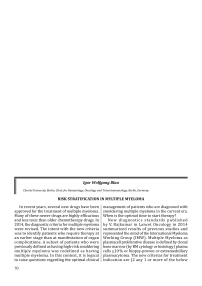Risk stratification in myltiple myeloma
Автор: Blau Igor Wolfgang
Журнал: Вестник гематологии @bulletin-of-hematology
Статья в выпуске: 2 т.15, 2019 года.
Бесплатный доступ
Короткий адрес: https://sciup.org/170171694
IDR: 170171694
Текст статьи Risk stratification in myltiple myeloma
In recent years, several new drugs have been approved for the treatment of multiple myeloma. Many of these newer drugs are highly efficacious and less toxic than older chemotherapy drugs. In 2014, the diagnostic criteria for multiple myeloma were revised. The intent with the new criteria was to identify patients who require therapy at an earlier stage than at manifestation of organ complications. A subset of patients who were previously defined as having high-risk smoldering multiple myeloma was redefined as having multiple myeloma. In this context, it is logical to raise questions regarding the optimal clinical management of patients who are diagnosed with smoldering multiple myeloma in the current era. When is the optimal time to start therapy?
New diagnostics standards published by V. Rajkumar in Lancet Oncology in 2014 summarized results of previous studies and represented the mind of the International Myeloma Working Group (IMW). Multiple Myeloma as plasmacell proliferative disease is defined by clonal bone marrow (by BM cytology or histology) plasma cells > 10 % or biopsy-proven or extramedullary plasmacytoma. The new criterias for treatment indication are (2 any 1 or more of the below
V Всероссийская научно-практическая конференция с международным участием «ГЕНЕТИКА ОПУХОЛЕЙ КРОВЕТВОРНОЙ СИСТЕМЫ —
ОТДИАГНОСТИКИ К ТЕРАПИИ»
Санкт-Петербург 26–27 апреля 2019 г.
listed myeloma defining events (actualized CRAB criteria)): Hypercalcemia: serum calcium 0.25 mmol/L (1 mg/dL) higher than the upper limit of normal or 2.75 mmol/L (11 mg/dL); renal insufficiency: creatinine clearance 40 mL/min and/or serum creatinine 173 mmol/L (2 mg/dL); Anemia: hemoglobin value of .2.0 g/dL below the lower limit of normal, or a hemoglobin value 10.0 g/dL; Bone lesions: 1 or more osteolytic lesions on skeletal radiography (ie, X-ray), low-dose CT, or PET-CT; clonal bone marrow plasma cell percentage 60 %; Involved/uninvolved serum free light chain ratio 100, and the involved serum free light chain concentration 10 mg/dL or higher; two or more focal lesions based on MRI studies of the skeleton.
With the introduction of the 2014 IMWG criteria for multiple myeloma, a proportion of patients previously considered to have smoldering multiple myeloma now fulfill the criteria of multiple myeloma requiring therapy. Ironically, with the change of the multiple myeloma criteria,the patients sometimes referred to as “ultra high risk smoldering multiple myeloma” (ie, very high risk of developing multiple myeloma) have become “ultra low risk multiple myeloma” because they now represent the earliest stage of multiple myeloma (ie, with a better likelihood of good clinical outcomes). Again, with the change of the definition of multiple myeloma in 2014, multiple myeloma no longer is a disease that requires symptoms. The old terminology “asymptomatic multiple myeloma” has become irrelevant (because it includes both smoldering multiple myeloma and some patients with multiple myeloma) and the currently correct terminologies are smoldering multiple myeloma and multiple myeloma requiring therapy.
In 2015, A. Palumbo published in Blood the revised international scoring system (R-ISS) included LDH and cytogenetic aberrations (interphase FISH) to level of albumin and beta2 microglobulin. This new risk stratification led to our recent understanding, based on genetic determined course of disease in individual patient. Following this new definition of different myelomas, clinicians started first time treatment programs last year based on this high risk criterias. This should be the future of myeloma treatment going on in direction to cure this disease.
Here we review and dissect data and models on the topics of clinical features, underlying biology and early treatment trials in smoldering multiple myeloma, and first trials based on cytogenetic aberrations. The presentation highlights assumptions, facts, and gaps in the literature. As indicated in the title of the paper, the recurrent theme of the text is this: shall we treat smoldering multiple myeloma in the near future and could we cure myeloma patients by differential therapy.


